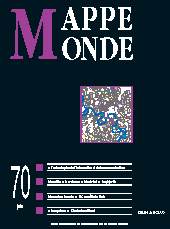

Cities and the new economy (3 fig.)
This paper analyses the spatial insertion of information and communication technologies (ICTs) in metropolises, then addresses the anti-geography myths generated by this new wave of innovation, which are premised on the effects of networks and distance-shrinking technology. Three approaches (urban hierarchy, reorganisation of metropolitan space, new urban objects) are used to show the importance of geography and the territorial issues surrounding ICTs.
keyword: CITY, ICT, INFORMATION SOCIETY, METROPOLIS, MYTHS, NEW ECONOMY, SPATIAL EFFECTS
Marseille, future ICT capital of the Mediterranean? (5 fig.)
In territorial development, ICTs have become a key economic activity. Keen to secure a favourable position for itself among large metropolises, Marseille is now playing the ICT card, through a major regional marketing drive (taking advantage of the development of the ICT sector in the conurbation and the region as a whole) and ambitious programmes to attract and retain businesses from this sector.
keyword: EUROMEDITERRANEAN REGION, ICT, MARSEILLE, PROVENCE-ALPES-CÔTE DAZUR, TERRITORIAL MARKETING
Bordeaux gambles on call centers (3 fig.)
Territorial policy-makers in the Bordeaux metropolis have recently positioned themselves on the call centre sector, despite increasingly fierce global competition. The logics of industrial location favour the metropolisation of teleservices. The metropolitan space preferred by this sector of the new economy are industrial zones on the urban periphery close to major communications networks (motorways, airports, etc.).
keyword: BORDEAUX, CALL CENTRE, INDUSTRIAL LOCATION, METROPOLISATION, TELESERVICE, TERRITORY
Montreal in the North American technodigital space (2 fig.)
Four sets of reasons explain Montreals major comeback on the North American scene: the importance of benchmarking ; the shift in favour of innovation ; the laisser-faire approach to industrial location ; and a frontal attack on the digital divide. Targeted initiatives to create intraurban technology districts are accelerating this trend.
keyword: DIGITAL DIVIDE, INNOVATION, MONTREAL, TECHNOLOGY DISTRICTS
Chrystel Alvergne, Daniel Latouche. The North American urban system in the era of the new economy (5 fig.)
Contrary to forecasts, the North American urban hierarchy is evolving towards a polycentric structure in which about ten cities can claim to occupy an important position. As a result of technoscientific change, the Internet and the new economy, we can now talk of specialised urban hierarchies and interlinked regional sub-groupings.
keyword: BOSTON, INTERNET, LOS ANGELES, NEW YORK, NORTH AMERICA, TECHNOSCIENCE, URBAN HIERARCHY
Denis Eckert. The Internet in Russia: an elitist symbol or a means of mass communication? (6 fig.)
The Internet, while firmly established among some classes of society, is still exotic for the majority of the population in many parts of Russia. For this reason, the government has launched an ambitious development policy. Even restricting our study to case of Moscow, the only place in Russia where the use of ICTs is widespread, we find that the Internet remains a highly selective phenomenon, both spatially and socially, despite plans to expand infrastructure and access, which should transform the capital into an «infocity».
keyword: INFOCITY, INTERNET, ICT, MOSCOW
Reykjavik at the time of Internet : a global metropolis miniature (1 fig.)
As a small capital city of an island in the North Atlantic, Reykjavik seemed far away from the globalisation/ metropolisation processes. Now, very high rate of Internet use stated in Iceland is for a large part a result of an anticipation. Supply preceeded demand. Reykjavik was able to grasp opportunities, recently the Internet. This anticipation was justified by major changes in the economy. A new metropolis is emerging close to the North Polar Circle.
keyword: ICELAND, ICT, METROPOLISATION
Bangalore, the city of new technologies (7 fig.)
Bangalore became the Silicon Valley of India. Some of the inhabitants have a westernized way of live but the other part of the population suffer from the dramatic growth of the city. Because of the weakness of the equipments, Bangalore is becoming less and less attractive for international firms.
keyword: BANGALORE, GLOBALISATION, ICT, INDIA
The One Billion Threshold in India (5 fig.)
The first results of the 2001 population census of India have been released. Officializing Indias crossing of the one billion threshold, datasets actually available confirm previous macro demographic trends : despite a slowdown of the demographic growth rate, India should soon exceed China in term of number of inhabitants. Through a map series at Indian district level, the authors refine these results by showing some of the main spatial shapes of the sub-continent. If almost all long term trends are confirmed in these maps, like the North/South opposition, some new situations are disclosed, reaffirming the need to think Indias model of development on many different levels.
keyword: DEVELOPMENT, INDIA, POPULATION
Book reviews (Gilles Puel et alii, Robert Ferras, Roger Brunet)
Mappemonde 1/03![]()
![]() Mappemonde 3/03
Mappemonde 3/03
For subscribe or buy this issue: BELIN
Last modified: June 4, 2003